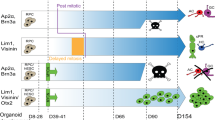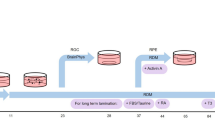Abstract
Neuroretina (NR) is an evagination of the central nervous system (CNS) which is composed of photoreceptors, glial (Müller) cells and horizontal, bipolar, amacrine and ganglion neuronal cells. We describe here the usefulness of Rous sarcoma virus (RSV) in the establishment of a neuronal clone from quail embryo neuroretina. When primary cultures of chick and quail embryo neuroretina cells are transformed by RSV, neuronal markers such as ribbon synapses, choline acetyltransferase (CAT) and glutamic acid decarboxylase (GAD) specific activity are present1. These RSV-transformed primary cultures can be established into permanent cell lines from which neuronal clones have been isolated. One of them, clone QNR/D, can generate tetrodotoxin(TTX)-inhibitable action potentials on electrical stimulation, has a high GAD activity and binds monoclonal antibodies raised against chick embryo neuroretina. The pres-ence of these neuronal markers suggests that the QNR/D clone is derived from cells of the amacrine or ganglionic lineage. This is the first time that a neuronal cell clone of defined origin has been obtained from the CNS. The neuronal markers of the QNR/D clone are expressed at both the permissive and the non-permissive temperatures for transformation.
This is a preview of subscription content, access via your institution
Access options
Subscribe to this journal
Receive 51 print issues and online access
$199.00 per year
only $3.90 per issue
Buy this article
- Purchase on Springer Link
- Instant access to full article PDF
Prices may be subject to local taxes which are calculated during checkout
Similar content being viewed by others
References
Crisanti-Combes, P. et al. Cell Differentiation 11, 45–54 (1982).
Kawai, S. & Hanafusa, H. Virology 46, 470–479 (1971).
Mirsky, R., Wendon, L. M. B., Blacks, P., Stolkin, C. & Bray, D. Brain Res. 148, 251–259 (1978).
Pettmann, B., Louis, J. C. & Sensenbrenner, M. Nature 281, 378–380 (1979).
Schnitzer, J. & Schachner, M. Cell Tissue Res. 224, 625–636 (1982).
Guérinot, F. & Pessac, B. Brain Res. 162, 179–183 (1979).
Raju, T. R. & Dahl, D. Brain Res. 248, 196–200 (1982).
Yavin, Z., Yavin, E. & Kohn, L. D. J. Neurosci. Res. 7, 267–278 (1982).
Narahashi, T. Physiol. Rev. 54, 813–819 (1974).
Kaneko, A. A. Rev. Neurosci. 2, 169–191 (1979).
Trisler, G. D., Schneider, M. D. & Nirenberg, M. Proc. natn. Acad. Sci. U.S.A. 78, 2145–2149 (1981).
Pessac, B. & Calothy, G. Science 185, 709–710 (1974).
Muto, M., Yoshimura, M., Okayama, M. & Kaji, A. Proc. natn. Acad. Sci. U.S.A. 74, 4173–4177 (1977).
Fiszman, M. Y. Cell Differentiation 7, 89–101 (1978).
Boettiger, D., Roby, K., Brumbaugh, J., Biehl, J. & Holtzer, H. Cell 11, 881–890 (1977).
Nelson, P., Ruffner, W. & Nirenberg, M. Proc. natn. Acad. Sci. U.S.A. 64, 1004–1010 (1969).
O'Lague, P. H. & Huttner, S. L. Proc. natn. Acad. Sci. U.S.A. 77, 1701–1705 (1980).
Author information
Authors and Affiliations
Rights and permissions
About this article
Cite this article
Pessac, B., Girard, A., Romey, G. et al. A neuronal clone derived from a Rous sarcoma virus-transformed quail embryo neuroretina established culture. Nature 302, 616–618 (1983). https://doi.org/10.1038/302616a0
Received:
Accepted:
Issue Date:
DOI: https://doi.org/10.1038/302616a0
This article is cited by
-
Stable expression of intracellular Notch suppresses v-Src-induced transformation in avian neural cells
Oncogene (2007)
-
RPE-derived factors modulate photoreceptor differentiation: A possible role in the retinal stem cell niche
In Vitro Cellular & Developmental Biology - Animal (2007)
-
p60v-src and serum control cell shape and apoptosis via distinct pathways in quail neuroretina cells
Oncogene (2002)
-
Characterization of a novel quiescence responsive element downregulated by v-Src in the promoter of the neuroretina specific QR1 gene
Oncogene (2000)
-
Physiological relevance and functional potential of central nervous system-derived cell lines
Molecular Neurobiology (1996)
Comments
By submitting a comment you agree to abide by our Terms and Community Guidelines. If you find something abusive or that does not comply with our terms or guidelines please flag it as inappropriate.



